Kohan 2 Review | Squads based tactics
Often when you buy a game, you know very well who the money goes to. In the case of Kohan 2, it's not that clear as the company that produced it, TimeGate Studios, went bankrupt in 2013.
Despite this, the game and its predecessor are still available for sale, good thing since the title has out-of-the-ordinary ideas.
Aesthetics
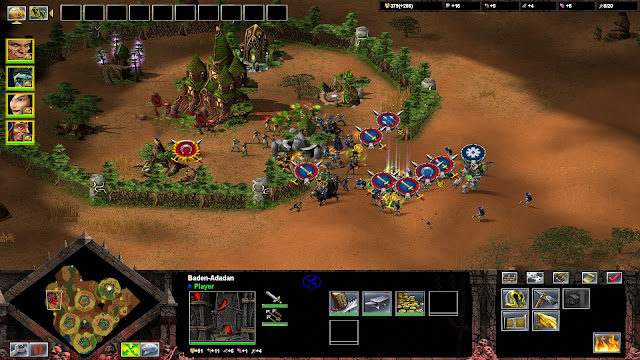 |
Besieging an enemy settlement |
Released in 2004, the 3D graphics used are not the best that could be offered at the time.
Two years earlier, Warcraft 3 was released, which had much more vibrant graphics, and around the same time, the first Lord of the Rings: Battle for Middle-earth was released too, which was much more detailed.
It isn't badly done, these two games simply had a better graphics.
The user interface is very descriptive, like when you are going to buy something, it will show how much you will spend. It also takes into account the maintenance costs for each unit and it shows the groups assigned to the quick keys on the top left.
One aspect that can be annoying are the unit icons, they are so large that they can obscure parts of the screen, making the action unreadable.
Particle details are sporadic and not noteworthy.
Animations are fine and even a bit dynamic, like when a unit focused on ranged combat, such as an archer, is engaged in hand-to-hand combat, the attack animation changes.
It's not just a difference in animation, it's a different attack with its own stats.
In most cases the dubbing is fine, except for a few performances here and there that are not up to par. They sound slightly underwhelming.
Passable soundtrack, with no great or bad tracks.
In summary, the models and textures could have been done better, otherwise it is a passable looking game.
Game Mechanics
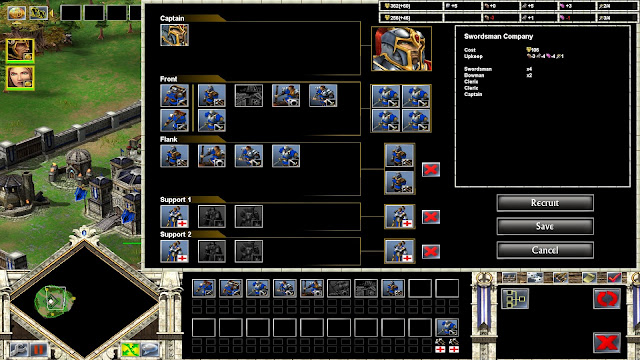 |
Designing the squads gives the possibility of particular combinations |
The title is a real-time strategy game where you command squadrons of troops, build cities to recruit, forts to defend, mines to gather resources and defeat your opponents with effective tactics.
A tip, if you think everything is going too slow, press the + button, it speeds up the game up to a maximum of 400% and, vice versa, you can slow down everything by pressing the - key. For the rest, the commands are those typical of a strategic game. You press ctrl plus a number to assign a group, you can give multiple orders in a row by holding down the shift key, the usual.
Formations are neat, each unit can be in one of 3 formations: combat (to maximize troop efficiency at the cost of speed), skirmish (to increase field of view at a moderate cost of combat efficiency) and column (to increase speed, but the squad becomes very vulnerable). All three have their own use cases suited to specific situations. Also, if a unit remains stationary for a while, it will entrench itself, receiving a defense bonus.
When two teams collide, everything happens automatically, making it impossible to manage troops, if you want to have someone retreat, you have to click on the appropriate button and choose an area far away enough, otherwise the squad will re-engage the enemy. When a unit runs out of morale it will rout, automatically retreating from the battlefield and it will not be possible to command it, beware it has happened to me more than once to lose a squad that had routed on the wrong way, keep an eye on your units before they go out of control.
You can regenerate life and fallen members when entering the supply zone of a city or fortress, but keep enemies away from your fortifications, when they are under attack they enter an under siege state, releasing the militia to defend themselves, but losing the supply area and the ability to heal the troops.
Speaking of cities, the construction of the buildings takes place mainly in the city centers. In them it is possible to build different structures, each specialized in the production of a specific resource. A building can be specialized to have additional effects: in general, you can choose whether the building is capable of producing the same resource in larger quantities, or you can choose to slightly reduce production in exchange for a small gold income. Once upgraded, a building will be able to research certain technologies that will improve the troop performance, these upgrades are almost all the same for the 6 races available, with the differences covering more particular aspects.
In the beginning, the city centers have few slots which, once filled, will allow you to advance the town hall to the next level. Upgrade as soon as possible, as an improved Town Hall increases the available slots, donates walls around the settlement (or upgrades them if already built) and increases the size of the militia. New cities can only be created on existing foundations on the map.
About the map.
Beyond the foundations, extra resources, neutral camps and monuments with guardians can be found on the game map.
To use the resources, you have to build a mine on them (a tip, build a fort near the mines, it will protect them from raids).
Neutral camps produce enemies that are not aligned with anyone and will attack everyone.
Monuments are useful as they grant some bonuses, it can be something simple like extra resources or something more interesting like exclusive units, plus monuments generate their own guardians even after conquest, they will not resist a firm attack, but they will give the main army time to arrive.
The missions follow a homogeneous structure, with the main objective being destroying all enemy forces or one unit in particular, about 70% of the missions have this goal, the rest is divided into entrenchment missions, reaching a safe place or building a certain structure.
All in the norm, without errors or exceptionality.
The save system is typical for the genre, with the ability to save at any time.
The difficulty can be decided before each mission, the two available settings are normal and hard.
A unique aspect of the game is the ability to customize teams and Kohans, these last ones are heroes that can be assigned to teams. Depending on the Kohan, he or she will be able to offer some types of support, like some are strong and do a lot of damage while others can heal troops. In case a Kohan dies, he or she will resurrect after some time, but will have lost all the levels gained during the battle. Both squads and Kohans can level up.
More on the squads, one consists of: a captain (mandatory), four front units (mandatory), 2 flank units (optional) and two separate support units (optional).
I really liked this system, with the right amount of imagination it allows you to create any combination you like, they can also be saved for later use, so you don't have to recreate the same team multiple times.
Support units are race dependent, as specific races have unique units, note that in order to recruit a unit type, you must have built the proper building, like archers who need a carpentry.
The races are semi-asynchronous, they all have the same tools at their disposal, with some implementation changes, for example, the undead can regenerate fallen soldiers without needing to be in the supply zone.
The artificial intelligence cheats, I have seen the computer in almost every level have an army far too large for the rules and resources available, but this is slightly mitigated by the fact that it tends to be a bit slow in action, so be aggressive before it reaches critical mass and overwhelms you, it also doesn't seem to be researching the technologies.
There are 5 resources: gold, rocks, wood, iron and magical gems, each of these resources has a special building that allows them to be collected. Most units have a maintenance cost of a certain resource in addition to gold, for example, archers also require wood. In case the production of a resource is not enough, money will be deducted from the earnings and each resource has a different penalty, from rocks that cost less to gems that cost more. To increase the limit of squads, barracks or new cities are needed to be built. Resources are used only for the upkeep of units and forts, they do not affect the construction of other structures.
I finished the game in 15 and a half hours on medium difficulty.
Simply put, the systems are implemented well and also have some interesting ideas that I haven't seen in other strategy games.
Narrative
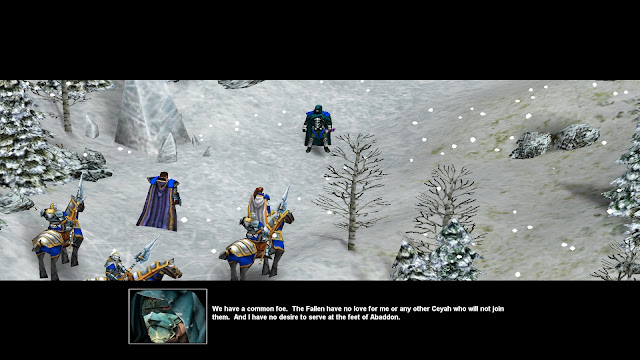 |
The cutscenes use the in-game engine |
In the fantasy world of Kaldun, a war is on the horizon, Ceyah forces have been spotted on the edge of the warriors of light territory. To avoid the worst, the council decided to send Navaa, kohan heroine sorceress, to investigate.
From here a series of events will begin, moving from various points of view to the end of the adventure.
The premise doesn't seem like anything special, but when you change your perspective in Ceyah's one, everything evolves in an interesting way.
We will witness several events receiving their due time, nothing seems to have been superfluous or useless to the main story.
Due to its linear campaign, the game has no side stories or extra narratives.
I was surprised by the characters, they are not cardboard cutouts, they receive a good deal of characterization. Who impressed me the most was Melchior, he has evolved since his first appearance and I think the ending to his story arc makes sense.
There are numerous quotes to various myths, but I didn't understand half of them, I think they are references to the previous game, It's been a long time since I played it, so I don't remember much. For the other half, they're a mix of typical generic fantasy myths and something more original.
Not bad, but it's not very emphasized.
To conclude, this isn't the most original narrative, but it's interesting enough to entertain until the very end.
Recommendation:
Kohan 2 is a game with interesting ideas and a surprisingly developed narrative, worth a look if you are looking for an atypical RTS. But who is getting the money?
Available on Steam.

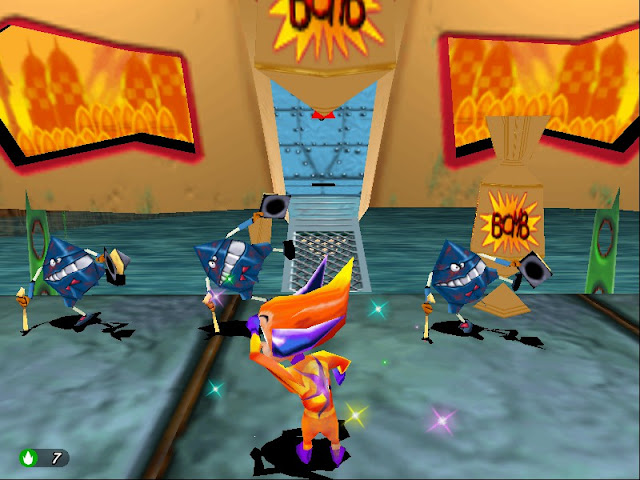
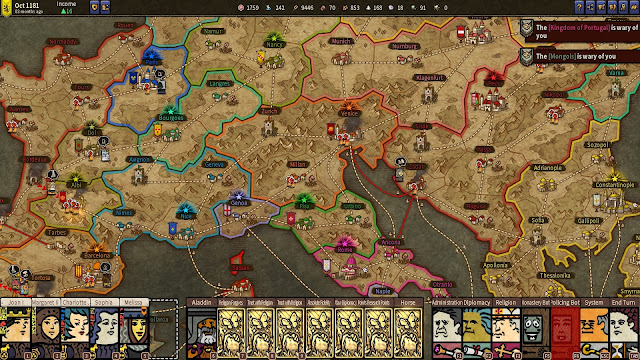
Comments
Post a Comment